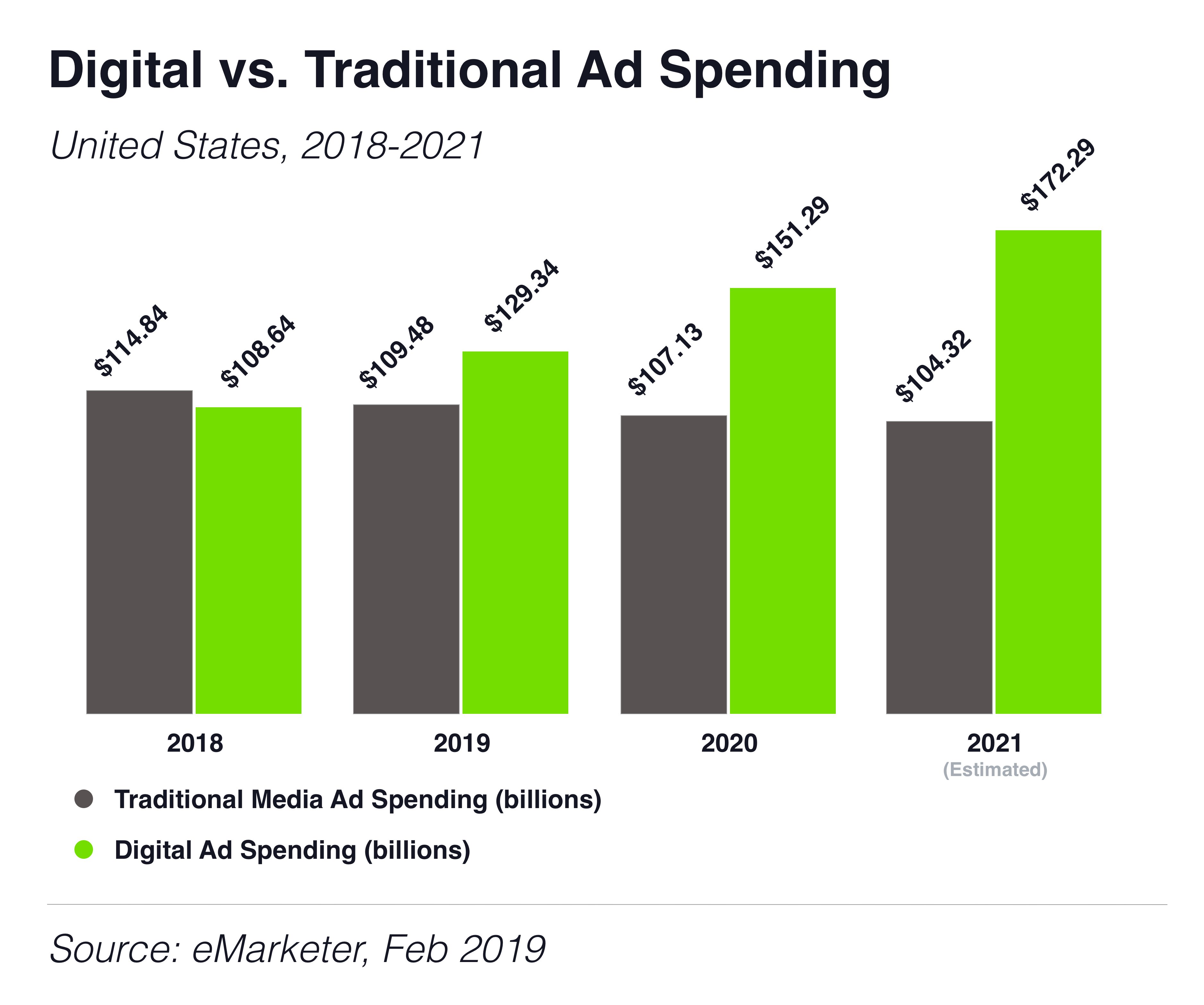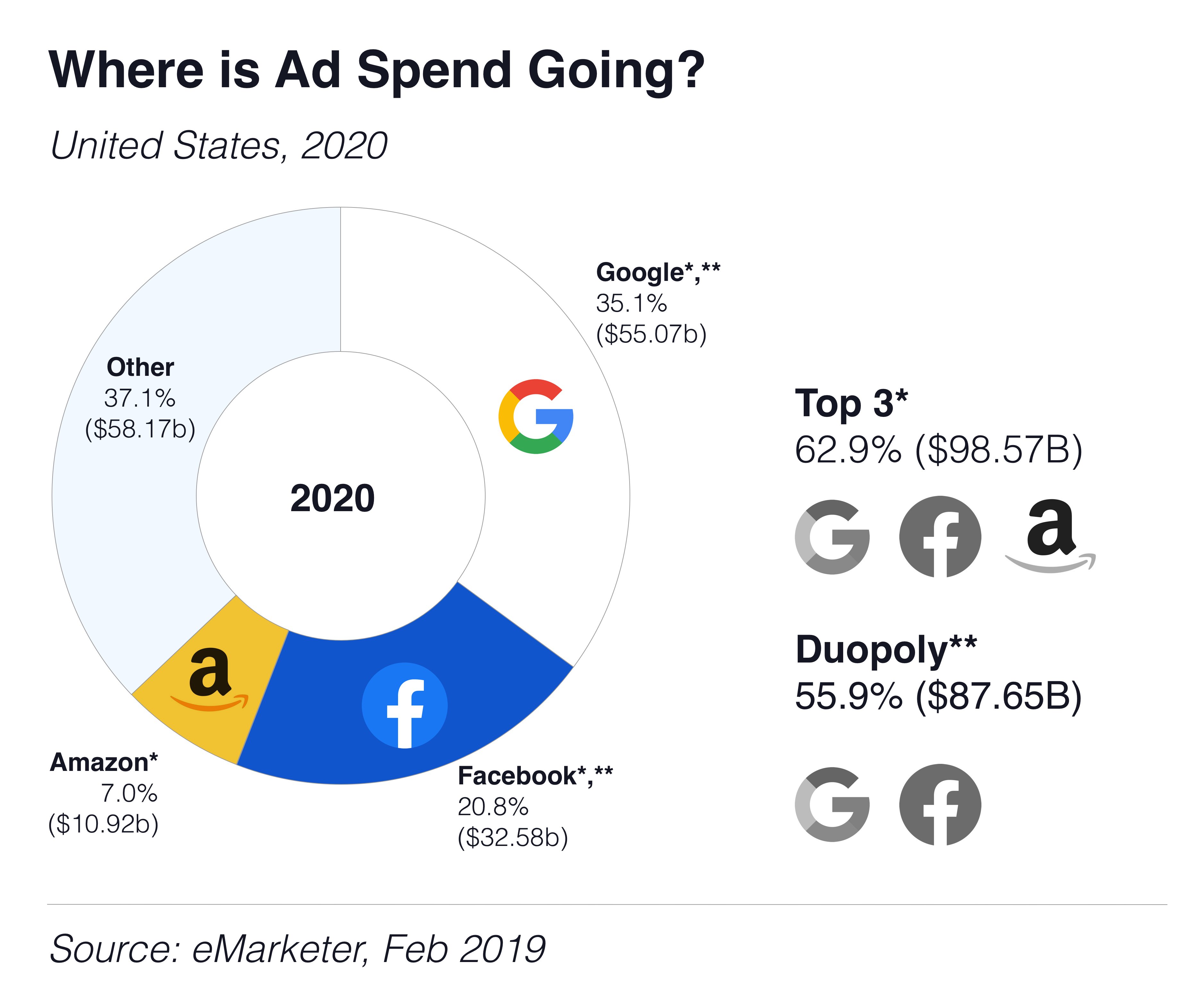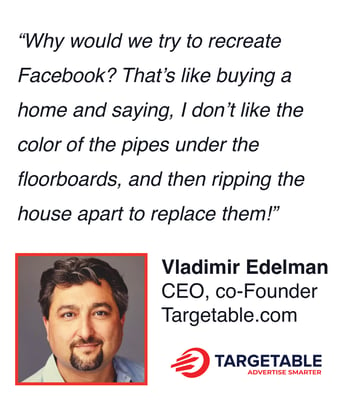
EXECUTIVE SUMMARY:
2019 marked an important milestone in the US advertising sector -- for the first time more dollars were spent on digital ads than on print and broadcast combined. This may seem far removed from the world of the small entrepreneur – the shopkeeper, restauranteur or local real estate broker. But understanding why digital and social media ads are displacing the old ways is a vital step toward success. With a small dedication of time and energy, busy small business owners can leverage the new advertising technologies and the massive database capabilities of Facebook, Instagram to grow revenue while controlling marketing costs. ![]() Download as PDF
Download as PDF
Amid all the hand wringing over digital privacy, disinformation and #FakeNews, a momentous digital media development passed in 2019 without much public fanfare. For the first time in history, US businesses spent more on digital advertising than on print and broadcast combined. Thus a trend that first upended the newspaper and magazine trade is now lapping away at traditional broadcasting, too. What’s more, streamlined interfaces powered by Artificial Intelligence (AI) and machine learning enable successful entrepreneurs and corporate leaders alike to leverage these technologies and optimize their ad spend ROI.
“Ad tech,” the umbrella term for the many analytical, creative and delivery platforms in the space, began modestly with pitches via email in the 1980s. As technology evolved, the Internet burst out of the lab. It jumped from desktops to laptops to smart phones, and innovative firms began finding better ways to deliver, measure and design online advertising content. Agencies once focused exclusively on print or broadcast hired html coders to create banner ads. Amazon pioneered recommendation engines while DoubleClick and others standardized the engagement and ROI metrics.
The vast majority of advertising today (over 80% in 2018) is “programmatic” according to American Advertising Federation, the industry’s trade group. Programmatic ads, unlike older customized ad content, are generated online using information provided by the buyer about target markets, ideal customers and messaging.
At the bleeding edge of this trend are firms employing Dynamic Creative Optimization (DCO)that apply Artificial Intelligence (AI) and machine learning (ML) to the process of producing, distributing and leveraging ads.
The 2020s: Growth, Consolidation and Regulatory Risk
Figure 1
The big news in 2019 was digital ad spend overtaking that of traditional ad platforms – print and broadcast. This is a milestone that has been both feared and yearned for ever since AT&T purchased the first known banner ad on Hotwired.com in 1994. And it has very important implications for business people everywhere, from small entrepreneurs to the CMOs of multinational corporations.
The ground is shifting and it is not going to be shifting back. eMarketer, a research firm that specializes in digital advertising and the ad tech space, says its forecast of $129 billion in US digital marketing spend in 2019 was exceeded. While eMarketer is still crunching last year’s numbers, it confidently predicts that digital advertising will not be looking back with growth driven by the proven results AI-driven digital ads produce, by innovators like Targetable, by increasing adoption of connected TV apps (Hulu, Netflix, HBO Go, etc..) and by growing use of devices like Xbox, PlayStation and Smart TVs to stream content. eMarketer forecasts programmatic US ad reaching $172 billion by 2021 (See Figure 1 above). To put that into proper perspective, digital made up barely 1/3rd of total ad spend in 2015.
While the growth trend will pose further challenges to the print and broadcast industries, digital advertising is exploding. So it should come as no surprise that some of the world’s most dominant companies, including Google, Facebook and Amazon, will capture nearly 57% of the US digital ad spending in the US market in 2020, according to the same research firm.

Figure 2
Google (which owns YouTube) and Facebook (which owns Instagram) have achieved something of a duopoly on digital advertising of various types over the past decade. Google’s ad words, relying on search to drive eyeballs, have established themselves as a staple of all major advertising campaigns in the corporate and retail markets. Facebook and its Instagram channel excel at something different – targeting individuals – a powerful formula for industries like restaurants, real estate, fashion and others that seek repeat business based on very specific consumer tastes. (See Figure 2 above).
This is precisely why Targetable makes it a point to leverage Facebook and Instagram’s unparalleled datasets. “Why would we try to recreate Facebook?” asks the San Diego-based company’s CEO, Vladimir Edelman. “That’s like buying a home and saying, ‘I don’t like the color of the pipes under the floorboards,’ and then ripping the house apart to replace them. Facebook is a juggernaut in terms of data, and data is the life’s blood of ad tech.”

Edelman’s approach stressed simplicity and ease of use. So Targetable’s app-driven interface turns Facebook’s complicated ad building machine into a more intuitive experience.
“We designed an interface that works a bit like Uber,” he says. “Instead of asking what color car do you want? How many cylinders? Electric or combustion engine? Uber just let’s you say, ‘I need a ride now. Send a car.’ Then Uber handles the complexity of which driver is closest, which car matches your behavioral profile, and how much that all is going to cost. That’s what we do for advertising. Targetable’s AI and machine learning looks at your restaurant’s social media and website profile, then creates ads for you for approval, rejection or editing. Simple as that.”
Besides the breakneck spending growth of digital ads and creeping consolidation of the market behind tech giants Google and Facebook, the third big ad tech trend are tentative steps by government to create standards around personal privacy and security issues. For small business owners, this is not much of an issue, particularly if their advertising primarily takes place on platforms like Facebook and Instagram. These and other large companies are the targets of the new data regulations and already they have spent millions ensuring they (and you, by extension) are in compliance.
In fact, while new regulations generally add complexity and cost to business operations, in this case the rules put in place by the EU in 2018 (the General Data Protection Regulation, or GDPR) and the California Consumer Privacy Act, which went into effect on Jan. 1, ultimately may save small business advertisers from having to think through the ins and outs of regulatory risk and compliance. The ad tech firms and big tech platforms that draw most of the money spent on digital ads will face steep fines if they mishandle personal data. That means it’s on them to fix the problem and not allow the well-meaning, busy entrepreneur to accidentally fall afoul of the law. An added incentive for the big platforms to get it right is the risk of tarring their corporate reputations.
Given all this, it may be tempting to decry the rise of a less orderly digital world and pine for the fading analog world, or to just sticking your head in the sand and keep running that ad in the local fish wrapper. But that is unlikely to be a smart business move. The ad tech space – indeed, anything with the word “tech” attached – can be daunting for busy professionals who have no desire to pretend they have the chops to work on Madison Avenue with Don Draper. But you don’t need to understand how to write html code or even how to navigate the detailed Facebook advertising interface. In fact, for those trying to reach a specific audience – whether that audience is defined by age, geography, job title, income, gender or some combination of those attributes– these are the good old days.
Today, with AI/ML driven creative engines like Targetable optimizing and harnessing the global power and data reach of Facebook and Instagram, standing up a digital ad campaign is easier, less time consuming, cheaper, and it produces more revenue per dollar spent.
Ad tech can seem complex but with the right tools it is a simple, cost-effective way to generate customers and revenue. Ignoring marketing and depending on word of mouth is not a plan, but rather it’s a decision not to have a plan at all. Similarly, calling old Joe at the local paper and telling him to run the same black-and-white ad every week for the next year on Page 9 is a denial of reality. Ad tech, whether it scares you or intrigues you, is where it’s at in the 2020s.
And there’s really no reason to be afraid. Creating an effective campaign requires you to do things that you should do anyway: defining who you are, what your business wants to achieve, what makes it special, who its ideal customers are and how much time and money you plan to devote to answering those questions.
Smart entrepreneurs – even those with a long history of acquiring customers and driving revenue with traditional print and broadcast spots – will adapt their strategies to synch with the changing realities of how people consume information. And that speaks to another milestone from 2019: the year that Millennials overtook Baby Boomers as the largest portion of the American workforce. If you want their business, you need to go where they are – online.
For more information, please call +1 201-264-5751 or email mike@targetable.com.
Targetable is an innovative digital marketing platform providing AI/ML driven creative and marketing services to the restaurant industry. Targetable not only uses automation to tailor ads to its customers marketing goals but also employs AI to produce the creative that data indicates will most effectively bring new customers to your enterprise. We put control of campaigns, creative and marketing decisions firmly in the hands of business owners, handling the difficult technical issues that used to require customization and expertise, and vastly lowering the cost per lead. That means businesses large and small can now avail themselves of the booming digital and social media advertising marketplace.
Schedule a demo with a customer success team member today!